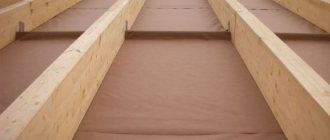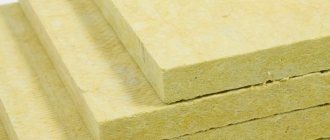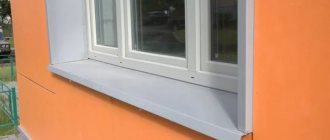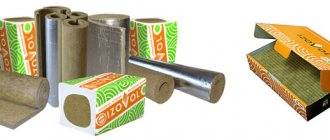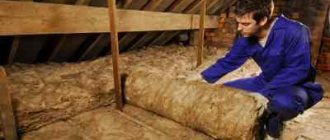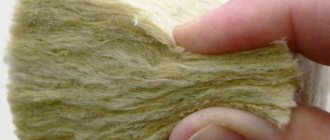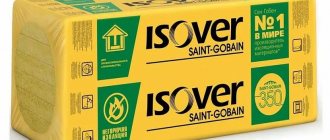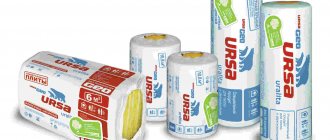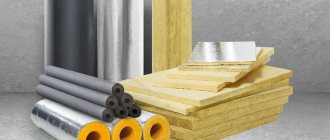Fibrous thermal insulation materials such as stone wool and glass wool are considered not only effective, but also safe for health. But this statement can be considered true only if the insulation is correctly laid and covered with a special film that does not allow fine dust from the fibers to pass through. However, during installation, the cotton wool has to be cut, cutting out pieces of the required sizes, and this process is certainly accompanied by the formation of microparticles that irritate the skin and mucous membranes and enter the lungs. Therefore, it is so important to know how to cut insulation in order to minimize the formation of harmful dust, and the cut is accurate and even.
Microparticles of insulation fibers become visible only when they settle on the surface Source chistyjdom.ru
Means of protection
Working with sharp tools always carries a risk of injury. But in the case of mineral wool insulation, it is minimal, since the sufficiently soft and pliable material does not require serious efforts, due to which the knife may slip in the wrong direction.
Much more dangerous is the inhalation of fine prickly dust, its contact with the eyes and skin, causing irritation. It is especially important to use protective equipment when working with glass wool and slag wool. The latter is not used in residential construction due to the toxic substances it contains, but it is sometimes used to insulate garages and other outbuildings.
Therefore, before cutting mineral wool, you need to prepare:
- clothes with long sleeves and trousers - to protect the skin;
- closed glasses that fit tightly to the face - to protect the eyes;
- respirator or multi-layer fabric mask - to protect the respiratory system.
When working with mineral wool, closed-type glasses are used Source prigor.ru
You will also need gloves that protect the skin of your hands not only from dust, but also from accidental cuts. It is best to take special polyamide ones with silicone or polyurethane coating.
Are there any nuances in transportation and storage?
*
Manufacturers recommend storing mineral wool in intact packaging, and it is better if the pack is placed on a flat surface. Each stack of packages should not be higher than 2 meters. Optimal storage conditions are closed rooms that are resistant to moisture. It is not recommended to store insulation outside, but if this happens, then you need to cover it with a tarpaulin or film.
Cotton wool should only be stored horizontally
When transporting, you should follow the same rules: transport the cotton wool horizontally and in a dry truck bed. It is also necessary to provide the material with protection from mechanical influences and precipitation. When loading and unloading material, do not compress it too much.
Unpacking mineral insulation also requires certain nuances. The material should be removed from the packaging only before starting work, which will minimize various risks associated with damage to the insulation. When laying out the material for cutting, use its packaging as a bedding. Thus, the product will not get dirty. Also, the packaging can be used to collect other waste at a construction site.
Cutting tool
How to cut mineral wool depends on the thickness and density of the insulation. The scope of work should also be taken into account. If it is small or the thermal insulation work is carried out once, you can get by with a regular cutting tool. If you have to insulate several objects, it is better not to waste money on a professional one.
See also: Catalog of companies that specialize in home insulation
Regular tool
Before cutting the mineral wool insulation, determine the thickness of the slab or mat. If it is less than or equal to 5 cm, for cutting you can use:
- construction knife;
- stationery or wallpaper knife.
Construction knife with a retractable segment blade Source ozone.ru
The main thing is that the length of the blade exceeds the thickness of the material being cut, otherwise it will wrinkle and the cut will turn out torn.
It is better to cut thicker insulation with other tools that you will probably find on the farm.
- A long kitchen knife, better for cutting bread with a serrated edge.
- Metal hacksaw with fine teeth.
- A hand saw or hacksaw with straight, fine teeth.
You can cut the insulation with a fine-toothed wood saw Source stroyday.ru
Residues of mineral wool
Mineral wool scraps can be used to insulate a doghouse.
After thermal insulation, a certain amount of unused material remains. Given its unique characteristics, there is no need to rush to get rid of slab scraps. They can be used usefully in the household. If this is not planned to be done immediately, the insulation must be sealed and placed out of the reach of children and animals.
It is advisable to use mineral wool for insulating the following structures:
- doghouse;
- pet barn;
- blind area around the house;
- garage walls and ceiling;
- home workshop;
- basement;
- cellar for food.
You can benefit from leftover mineral wool by handing it over to a recycling collection point. The accepted material is sold to enterprises that make granules from it, which are used for re-production of insulation.
Tips for cutting insulation
To prevent the material from tearing when cutting, creating a large amount of dust and waste, the tool must be sharp. Due to the nature of the insulation, consisting of stone or glass fibers, it quickly becomes dull and requires frequent sharpening. Or, in the case of a utility knife, replacing the blade.
Before cutting mineral wool in slabs, markings are applied to them, an even strip is pressed against it and the cut is made by pressing the tool blade against the guide and holding it vertically.
To cut rolled insulation, markings are made directly on the packaging, gluing masking tape around its circumference.
It is important! In order for the insulation to fit tightly to the side edges of the frame or rafters, its width should be 5-20 mm greater than the distance between them. Take this into account when marking.
How to cut mineral wool
For soft boards, the edge should not be damaged, so as not to subsequently create cold bridges during operation.
The main technical condition of the process is to preserve the structure of the material - the fibers must remain intact and maintain their position in space. To ensure that the dividing lines are accurate and even, you should first apply the markings with a marker using a tailor's meter or rule. You need to cut the slabs by placing them on the table so that the cutting line is suspended. After this, you should make forward movements with the tool, avoiding excessive pressure.
You need to finish sawing by holding the cut fragment suspended so that it does not come off under its own weight.
External wall insulation technology
Insulating the façade with cotton wool is done using glue and special dowels with a large head. The material is supplied in the form of rolls or slabs, which are cut into pieces of the required size. You will also need a metal profile or wooden blocks between which the insulation will be fixed. You can cut the material with an ordinary sharpened knife. However, if the density is high enough (80-100 kg/cubic m), then you will have to cut it using a hacksaw. Insulation of the facade is carried out in the following order:
To cut basalt insulation, it is best to use a mounting knife.
- a vapor barrier film is attached to the wall; it must release moisture under the mineral wool slabs and prevent cold air from entering the house;
- Then wooden blocks or a metal profile are attached to the wall in a vertical position. Their width should correspond to the thickness of the insulation. The interval between the posts should be such that the mineral wool is inserted with little effort;
- The insulation is fastened with glue and special dowels if the wall is stone, or with nails (screws) with large washers if the surface is wooden. For 1 sq. m you need 5-6 pieces;
- It is recommended to lay a windproof membrane on the fixed basalt wool, the joints of which are taped with adhesive tape;
- To ensure ventilation under the subsequent decorative coating, it is advisable to make a counter-lattice over the slabs from wooden blocks or a metal profile 10-15 mm high.
Insulation scheme using basalt wool.
This technology is suitable when facade insulation under siding is required. However, in some cases, for example, in multi-story buildings, it is necessary to secure the insulation more firmly. In this case, it is additionally fixed to the surface with glue, and reinforcement is carried out at the same time. This operation strengthens the structure and dampens the thermal expansion of the material, which can contribute to the formation of cracks and increase thermal conductivity.
Reinforcement is made on the already installed insulation using special glue and mesh that is resistant to alkali. First, glue is applied on which the mesh is laid, then it is covered with another layer of adhesive. The final decorative finishing can be done using facade paint and decorative plaster.
Manufacturers
Several well-known companies operate in the basalt insulation market. TechnoNIKOL and Rockwool companies have earned positive reviews and a good reputation. High quality, wide range, excellent product characteristics explain the popularity of materials of these brands among consumers.
TechnoNIKOL basalt insulation
TechnoNIKOL Corporation is a large Russian holding. On the market since 1992. Production sites and branches are located in 38 countries. TechnoNIKOL's rich assortment of basalt wool will allow you to choose the right type of insulation.
1.Technolight. Used for heat and sound insulation of surfaces with low external loads. Insulate pitched roofs, floors, attic walls, and ceilings in attics. Thickness – 40-200mm, density – from 30 to 40kg/m3.
2.Technovent. The main purpose is insulation in residential and industrial premises. Component of a ventilated facade. Thickness – 40-200mm, density – from 80 to 100kg/m3.
3.Rocklight. I insulate horizontal, vertical, inclined structures. Among them: floors, ceilings, multi-layer frame walls, attic space. Thickness – from 50 to 100mm, density – 30kg/m3.
4.Technoface. The slabs are used in industrial and civil construction. Suitable for thermal insulation of facades. Decorative plaster can be applied on top of them. Thickness – from 40 to 240mm, density – 145kg/m3.
5.Technoflor. Three types. SOIL – for insulation of heated floors and floating floors. PROF is needed where there is a large load on the floor - in warehouses, gyms. STANDARD – for floating floors that require a thermal insulation layer. Thickness – from 20 to 150mm depending on the type. Density – from 90 to 110 kg/m3.
6. Technonikol stitching mat. Fire protection, thermal insulation of residential and industrial buildings. A galvanized mesh is attached to the mat to facilitate installation and add rigidity to the finished structure. They insulate ventilation ducts, cylindrical, flat, cone-shaped surfaces, heating up to +750C. Thickness – from 40 to 200mm. Density – from 80 to 100 kg/m3.
Foil-coated basalt wool is also included in the list of TechnoNIKOL products. Available in rolls. The cost of TechnoNIKOL basalt insulation varies. The popular type Rocklight costs 1,300 rubles/m3. The most expensive material is with a density of 180 kg/m3 - Tekhnoruf B60 - 6000 rubles/m3.
Rockwool basalt insulation
The ROOCKWOOL group of companies unites enterprises from different countries.
Representative offices and production facilities have been opened in Russia, Belarus, and Ukraine. On the market for more than half a century. Rockwool products are used in premises for various purposes. Review:
1. Fire insulation. Rockwool basalt wool is used in shipbuilding for thermal insulation of devices with fire and explosion hazards.
2.Technical insulation. Indispensable for air conditioning systems, ventilation ducts, chimneys, heating systems, pipelines, boilers and tanks. Insulates parts and devices with high and low temperatures.
3.Passive fire protection systems. Rockwool stone wool is needed for fire resistance of floors and steel structures, for the protection of chimneys and ventilation shafts.
